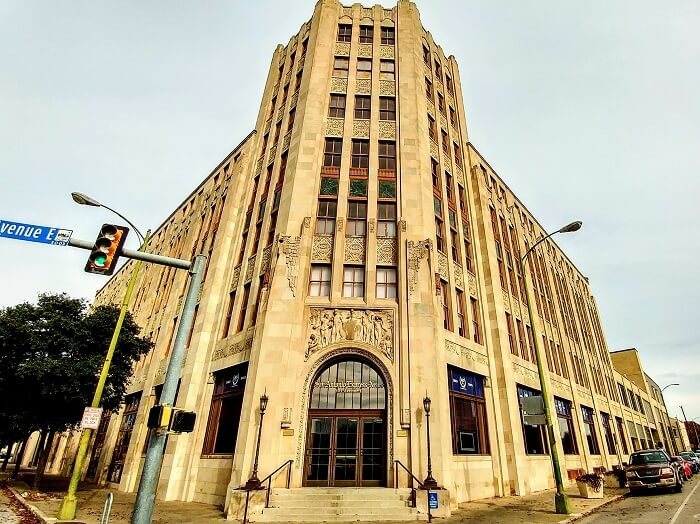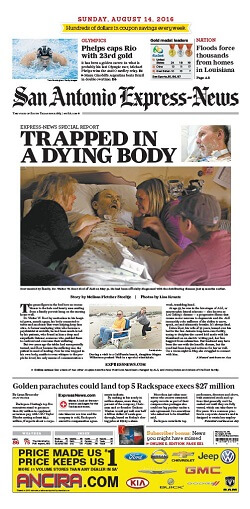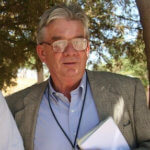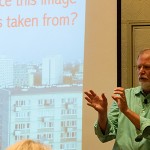
The next time someone tells you newspapers are irrelevant, tell them to read this blog post.
I get it. Newsrooms are shrinking, subscription are going up, and it feels like there’s not enough time in the day to read some dusty old newspaper — even if it comes in a slick digital version.
But that doesn’t change the fact that major metropolitan newspapers still boast the largest newsrooms in their communities. By a mile. More than TV stations. More than radio stations. More than every local blog combined.
Before you send me an example showing a newspaper didn’t live up to its potential, let me save you some time. I agree with you. Newspapers have many faults. But even with many faults, newspapers are still worth reading. No other local publication in your city invests the time and resources to tell readers something new and amazing about the world. Many days — not every day, but many — you’re simply missing out if you don’t read it.
Let’s look at just one example, the San Antonio Express-News, where I work. If you didn’t read San Antonio’s daily newspaper in 2016, here’s a sampling of what you missed.
(Full disclosure: These articles were written by my colleagues, many of whom are friends and, in one case, the mother of my children. All their stories still kick ass.)

The Next Million: Did you know San Antonio will grow by a million people by the year 2040? Do you know what that means for you and what city officials plan on doing about it? Express-News Staff Writer Vianna Davila spent a year finding those answers. That’s right. She got paid to spend a whole year on this package of stories about an issue that directly affects you and your kids.
For the past year, the San Antonio Express-News has interviewed scores of people — homeowners, renters, planners, experts and developers — to understand and examine past and present growth in San Antonio and Bexar County, as local officials begin to confront a startling possibility: Today, nearly 1.9 million people live in Bexar County, but the population is expected to grow by another 1.1 million people by the year 2040.
With this increase will come unprecedented demand for more housing, jobs and seats in classrooms; it will put tens of thousands of new vehicles on the roads.
How to accommodate so many new people is a staggering challenge, in a place where development already has spread in virtually any direction it wants, unconstrained by any natural barriers, in order to meet the needs of a city and a county that’s been steadily growing for decades.
The Endless War: Soldiers are still fighting and dying in the Middle East, and the Express-News has not forgotten them. The paper sent Martin Kuz, a military writer who used to work for Stars and Stripes, to Afghanistan to write about the endless conflict. Martin and Military Reporter Sig Christenson have also covered the surge in suicides among troops who return home and grapple with post traumatic stress disorder.
These are painful, emotionally fraught minefields that Martin and Christenson routinely navigate to write stuff like this:
Richard Rodriguez brooded in his backyard on a cool evening in March after another argument with his wife. The idea to end his life bloomed in his mind with cold conviction.
The former Army reservist stood up and began walking toward the freeway a few miles from his house in Harlingen. He wanted to reach a particular curve that lies beyond the glow of streetlights.
In that dark emptiness, when the moment beckoned, he would hurl himself in front of a vehicle. He would quiet at last the chaos inside that he carried home from Iraq six years earlier.
Rodriguez rationalized that the location was far enough from the house that his wife, Vicky, and their three young children would seldom pass by the site. Nor would the date of his death coincide with their birthdays, the couple’s wedding anniversary or any other meaningful family occasion.
“I had everything figured out,” he said. “The best way to help everyone was for me to die.”
 Death of a Jurist: Express-News readers were the first to learn that Supreme Court Justice Antonin Scalia had died at a West Texas ranch. The paper’s scoop was the result of luck and hard work that began with a tip to Express-News veterans Bruce Davidson and former Washington correspondent Gary Martin. That tip sparked a mad scramble of reporters to call their sources to confirm the story.
Death of a Jurist: Express-News readers were the first to learn that Supreme Court Justice Antonin Scalia had died at a West Texas ranch. The paper’s scoop was the result of luck and hard work that began with a tip to Express-News veterans Bruce Davidson and former Washington correspondent Gary Martin. That tip sparked a mad scramble of reporters to call their sources to confirm the story.
Reporter John MacCormack was already in West Texas with photographer Edward Ornelas. “Johnny Mac” has covered the region for years and can often be heard in the newsroom pestering sources for news, asking gems like, “What are you going to give me so I don’t write the usual blather?” MacCormack and Ornelas showed up at the ranch in time to see the hearse leave with Scalia’s body.
“The death of a Supreme Court justice might be the definition of a national news story,” wrote Slate staff writer Leon Neyfakh about the scoop. “The fact that it was first reported by a local newspaper is a dramatic reminder of just how valuable it can be to have seasoned journalists in place when big news happens.”
State senator tied to bizarre bankruptcy: Newspapers excel at sending reporters to mundane meetings and court hearings, and reporters excel at complaining about those assignments. But that grunt work leads to hidden nuggets of news.
Check out my Q&A with business writer Patrick Danner, who mines court records looking for good stories. Danner attended a bankruptcy hearing and stumbled upon a bizarre case involving state Sen. Carlos Uresti, D-San Antonio. Uresti is a lawyer, and one of his clients accused him of persuading her to invest $900,000 in a company that later went bankrupt:
About 10 months after a legal team including state Sen. Carlos Uresti secured a substantial settlement for Denise Cantu in a wrongful-death lawsuit, she invested $900,000 — the bulk of the proceeds — with a San Antonio frac-sand company that was paying the senator commissions for attracting investors.
Uresti helped represent the Harlingen woman in the case after the rear tire on her Ford Explorer blew out, causing the SUV to veer into a grassy median, roll over and kill her 13-year-old daughter, 4-year-old son and two friends in August 2010.
Now, most of Cantu’s money is gone, along with at least $5 million the frac-sand company, FourWinds Logistics, raised from three other investors, a filing in federal bankruptcy court here shows. Total claims against the company exceed $14 million, another document states.
Some investors have accused FourWinds, which now is in bankruptcy and out of business, of fraud. At least one has called it an illegal Ponzi scheme.
Danner continues to bird-dog the story as the FBI investigates and company officials face criminal charges.
 Behind from the Start: Did you know that one in every six women who gave birth in Bexar County in 2014 received no prenatal care? Local health officials didn’t know about that astonishing statistic — until former Staff Writer Jessica Belasco asked them about it.
Behind from the Start: Did you know that one in every six women who gave birth in Bexar County in 2014 received no prenatal care? Local health officials didn’t know about that astonishing statistic — until former Staff Writer Jessica Belasco asked them about it.
Check out her deeply researched series of stories about premature births and the high rate of mothers who only receive prenatal care late in their pregnancies — or not at all:
In recent years, the prenatal care deficit has grown worse in Bexar County, a trend undetected by local health officials until they were asked about it by the Express-News for this series.
Nearly one in every six women, or 15.4 percent, who gave birth in Bexar County received no prenatal care in 2014. That’s up from about one in 40, or 2.7 percent, just three years earlier, according to the most recent figures from the San Antonio Metropolitan Health District. By contrast, the rate for Texas overall was 4.6 percent in 2013.
Add the nearly 4,000 pregnant women who didn’t get any care with the more than 6,000 pregnant women who received care late in pregnancy — after the first trimester — and the rate hits a staggering 39 percent of all live births in Bexar County in 2014.
“It’s a significant issue in our community,” said Dr. Thomas Mayes, head of pediatrics at the UT Health Science Center. “In a country that has a wonderful health system, there should be virtually nobody that doesn’t get prenatal care. Nobody.
“Richest country in the world, and we have this kind of rate. It’s just a travesty, to be honest with you.”
Hard Times Hit Eagle Ford: No reporter has covered the Eagle Ford Shale oil boom — and bust — as prolifically as business reporter Jennifer Hiller. She’s written about wildcatters, out-of-control gas flares, pollution, and workers whose lives look like something out of a sad country song, just to name a few. Her mileage reimbursements will put our kids through the first year of college.
Jennifer has driven everywhere and met everyone in the Eagle Ford Shale, which explains how she was able to write this tragic story about the high death toll at drilling sites in the Eagle Ford — she had met one of the victims before his death:
In January 2013, Nestor Lerma Jr. paced the perimeter of a dusty oil drilling site, cellphone pressed to his ear, struggling to hear over the noise of diesel engines as he called Danielle Daniel.
She was eight months pregnant, and he checked on her each time he climbed down the derrick.
“Some days she gets really stressed. I can hear it in her voice,” Lerma said. “That’s what the oil field is. You have to be away from your family.”
They had been together three years, so Daniel knew all about this life — time away from home, missed holidays, the scent of oil on Lerma’s skin. It was the smell of money. It meant bills would get paid.
“I do get scared that one day I’m going to get that phone call,” Daniel said at the time. “That’s the only thing I don’t like about that whole situation. If something happens to J.R., they can replace him. We can’t. We can’t replace him.”
On May 1 this year, she got the call, or a version of it, when a police officer tracked her down in person.
Lerma, 38, was dead — one of at least 34 oil field workers in South Texas who have died on the job in recent years.
Covering the Cartels: The Express-News’ border coverage frequently goes beyond the border. Jason Buch, who covers immigration and border affairs, journeyed to El Salvador, the most violent country in the world, to explain why residents are fleeing en masse to the United States.
But avid readers of the Express-News know there’s a wealth of information about the cartels that’s buried in court files across Texas. They know this because Buch monitors money-laundering cases and criminal trials that often reveal far more about cartels such as the Zetas than the Mexican government has ever made public.
One trial Buch and federal courts reporter Guillermo Contreras covered shed light on the Allende massacre:
In Piedras Negras, the Zetas were frantic.
There wasn’t much that could bother the cartel in one of its strongholds. Its gunmen patrolled the Mexican city across the Rio Grande from Eagle Pass in caravans of armored vehicles, casually displaying automatic rifles and rocket-propelled grenade launchers. Police stayed out of the way. The gang’s leaders even owned one of the city’s biggest commercial developments.
In March 2011, however, Mario Alfonso “Poncho” Cuellar, a major trafficker from the region, had gone missing. He wasn’t a member of the Zetas but worked closely with the cartel’s then-No. 2 boss, Miguel Treviño Morales. He was the godfather to the children of Treviño’s brother Omar.
And now Cuellar, the Zetas correctly believed, was in the United States, cooperating with federal agents.
“It was panic time in Piedras because Poncho Cuellar had flown away from them,” a federal witness named J. Rodríguez said. “They picked up every single person who had anything to do with him.”
So began what became known as the Allende Massacre, the disappearance of as many as 300 people named for the small town near Piedras Negras where many of them lived, according to testimony this month in a San Antonio federal courtroom.
The trial drew the first clear connection between the allegations of corruption and the mass killings in Mexico.
“Guillermo and I have been nibbling around the edges of these court cases in Texas that have to do with corruption in Mexico, but they always end in plea deals and very little information is made public,” Buch told me.
“In 2014 I went to Saltillo, the capital of the Mexican state of Coahuila, because a lot of former officials have property in San Antonio and some are being investigated by the U.S. government. In 2015 I went to Piedras Negras and Allende, Coahuila, to write about mass disappearances there at both the hands of the cartels and the police. This trial, for the first time, really drew a line between the allegations of corruption and the killings in northern Mexico.”
 Trapped in a Dying Body: Everyone with a Facebook account remembers the Ice Bucket Challenge. But Express-News readers learned what ALS really does to its victims and their families when Melissa Fletcher Stoeltje wrote about the devastating effects of ALS, a fatal condition that ruins the body while the mind is lucid.
Trapped in a Dying Body: Everyone with a Facebook account remembers the Ice Bucket Challenge. But Express-News readers learned what ALS really does to its victims and their families when Melissa Fletcher Stoeltje wrote about the devastating effects of ALS, a fatal condition that ruins the body while the mind is lucid.
Stoeltje focused like a laser on one family struggling with the incurable disease. With unique access to the Root family, Stoeltje was there until the end. She writes with a touching but unflinching style:
There were indications the end was near.
Walt had lost interest in things he used to care about — getting in his chair, going outside, watching movies; even “The Ghost Whisperer” had lost its charm.
There were physical signs as well. The swelling. Blood mottling in his extremities. Agitation where he pulled on his sheets, anxiety that was likely linked to a sensation doctors call “air hunger.” Fevers that arose when the sun went down. His fingernail beds were blue.
A hospice nurse now was in his room constantly. Walt was getting regular doses of morphine to help with the air hunger.
Debra, a pillar of strength thus far, was taking these changes hard.“I went home the other day and just sat on the couch and wailed,” she said.
Even now, though, when his room filled with visitors, Walt tried to rally, some light returning to his eyes. He never wanted anyone to leave.
Debra’s pastors have counseled her to assure him that all will be well.
“They said, ‘You need to give him permission to let go,’” she said. “But I don’t want him to go yet. I’ll know the right time. I don’t think he’s ready to go yet.”
Buttressing all these fine stories were editors, photographers, designers, and graphic artists that made them even more compelling. Stoeltje wasn’t the only one bearing witness — photographer Lisa Krantz was there, too, making a story about death come to life with powerful images.
The daily miracle of newspapers is that they’re under siege from external pressures and internal inertia, yet somehow keep cranking out good stuff. And these were just the big stories I remembered. There were many, many more that scraped beneath the surface of news events that other outlets covered superficially, while the Express-News told readers what was really going on.
I can’t say what newspapers will look like in the coming years, but I hope they’ll stay just as relevant as they are now. Here’s to 2017.



